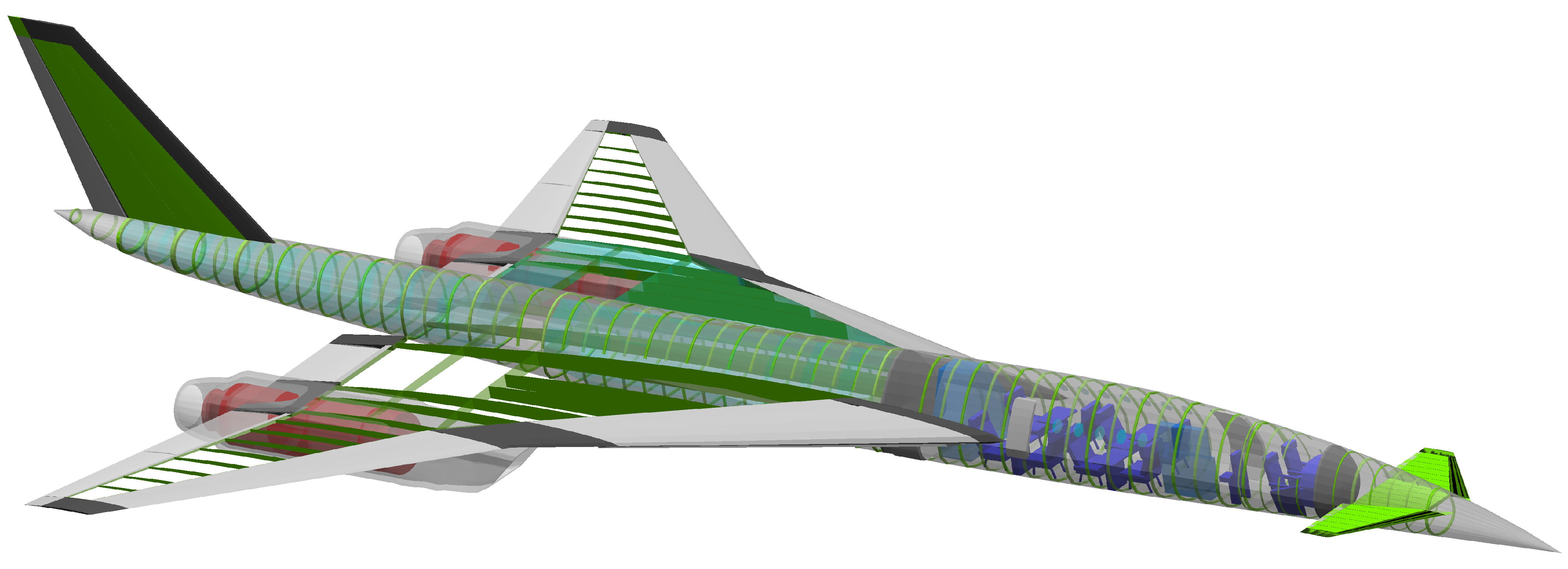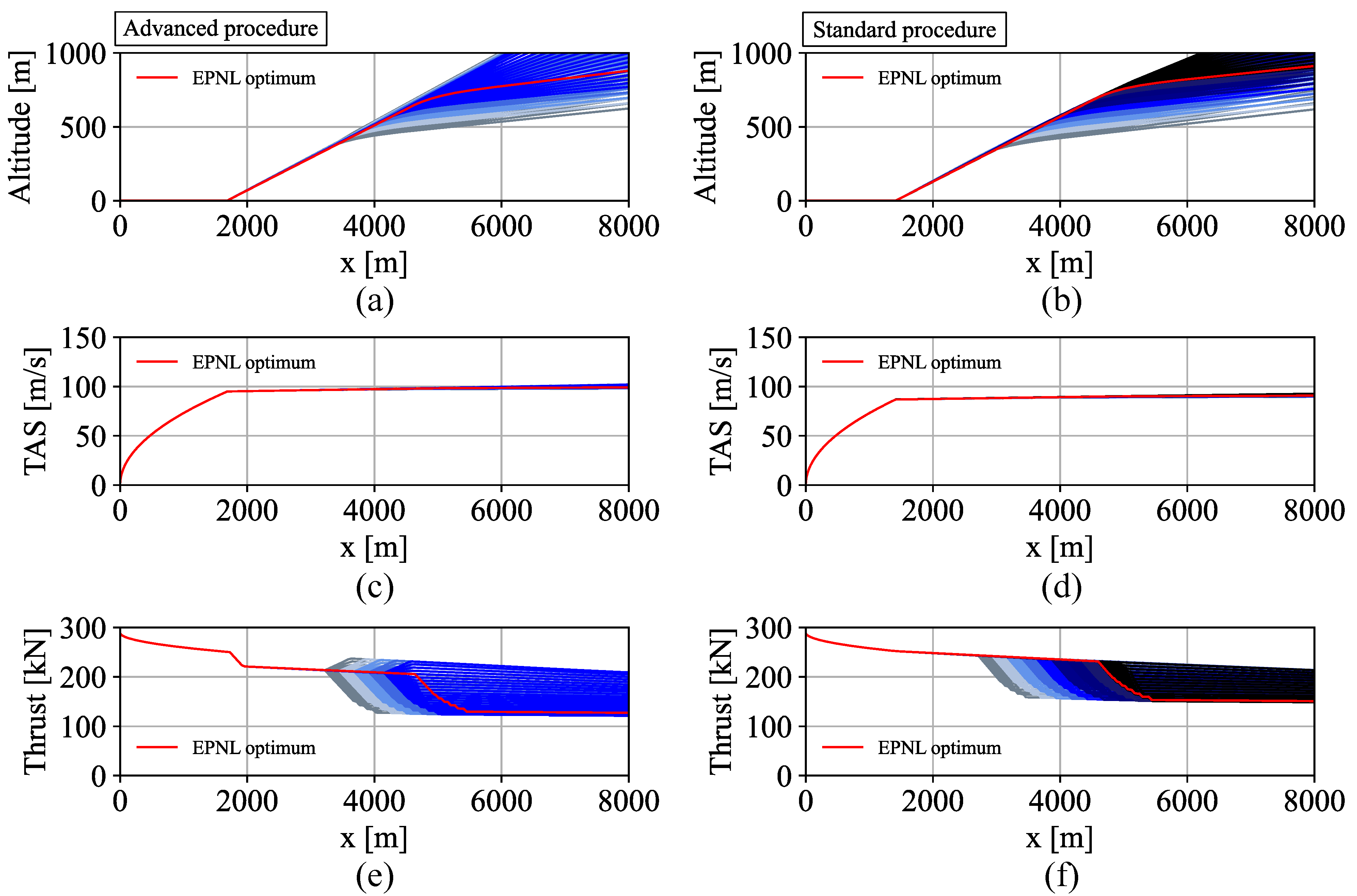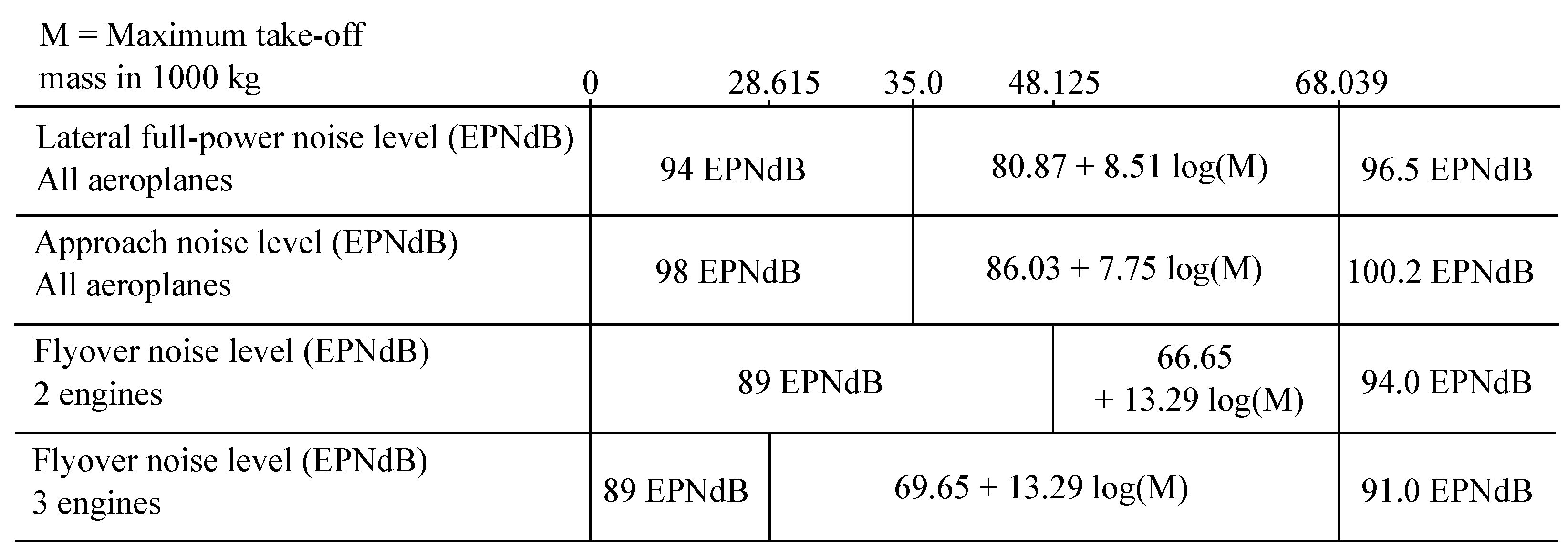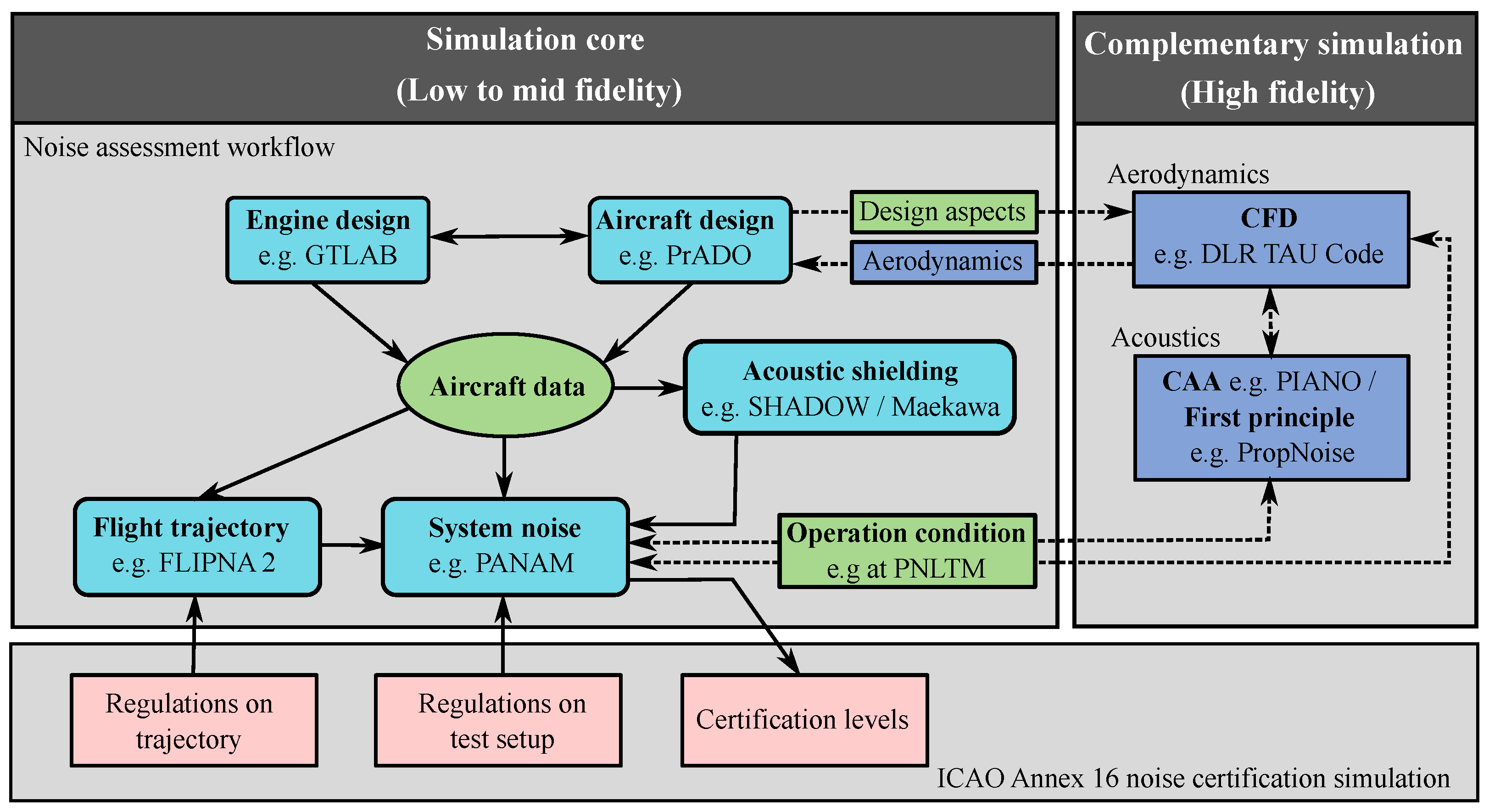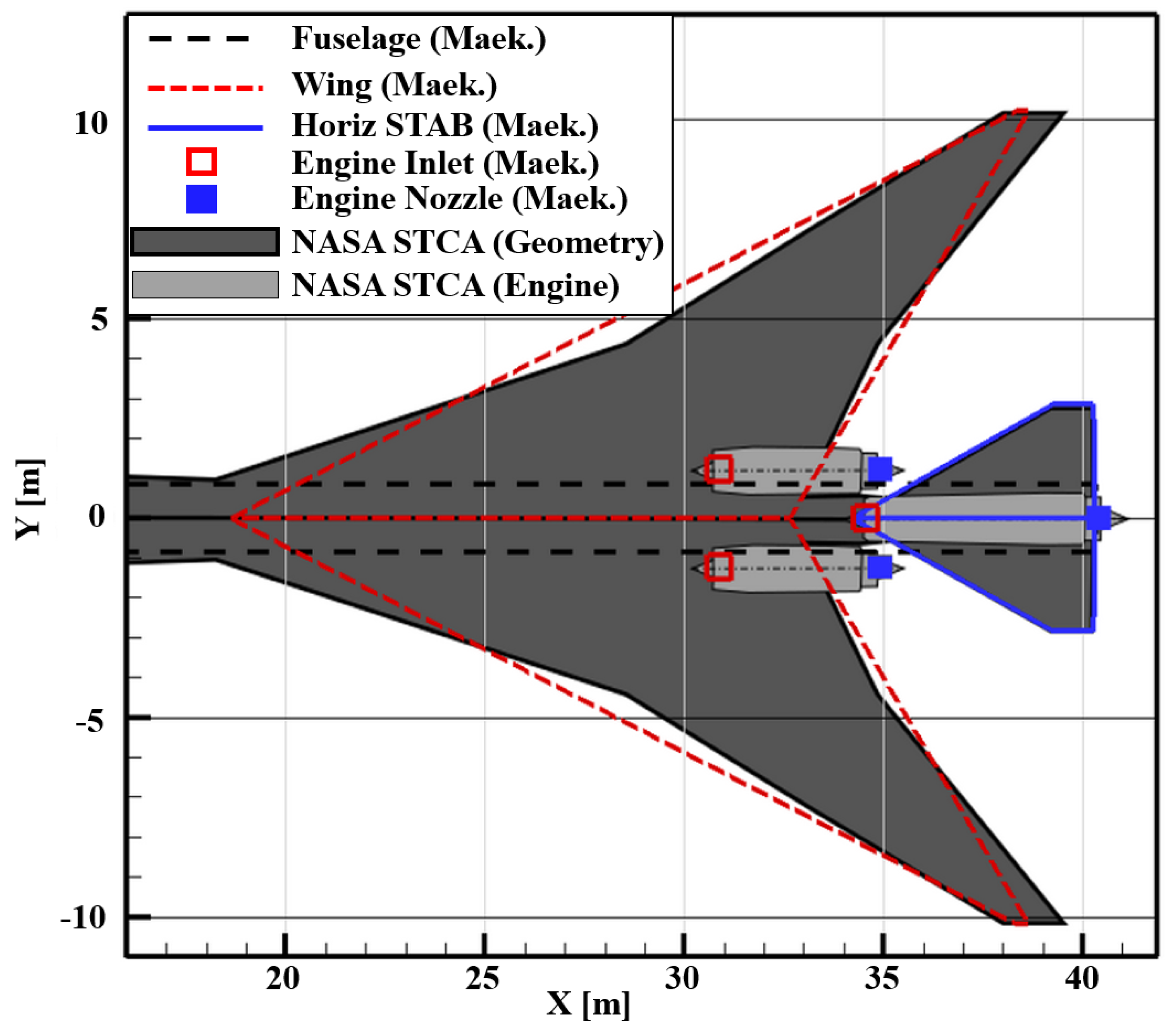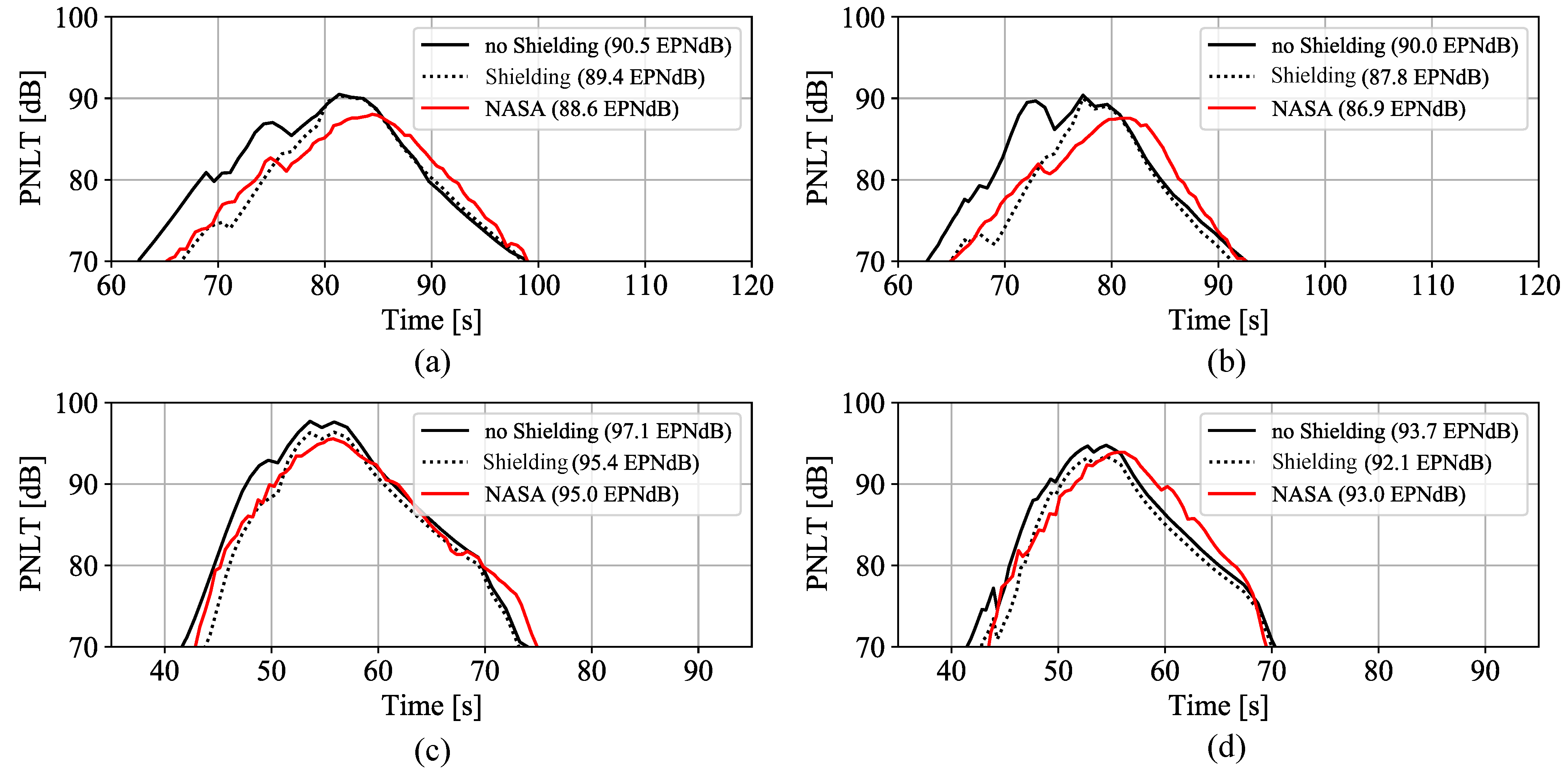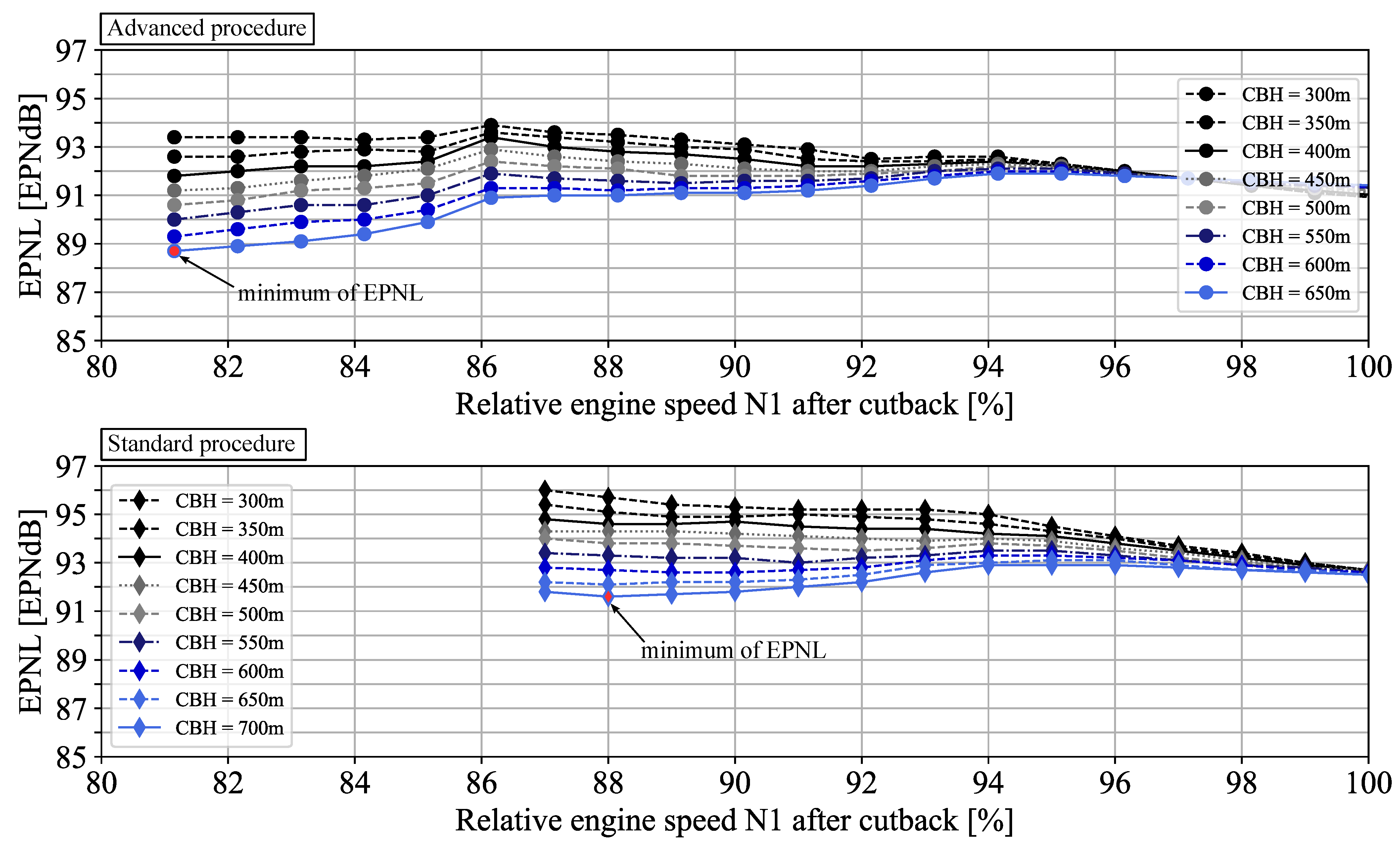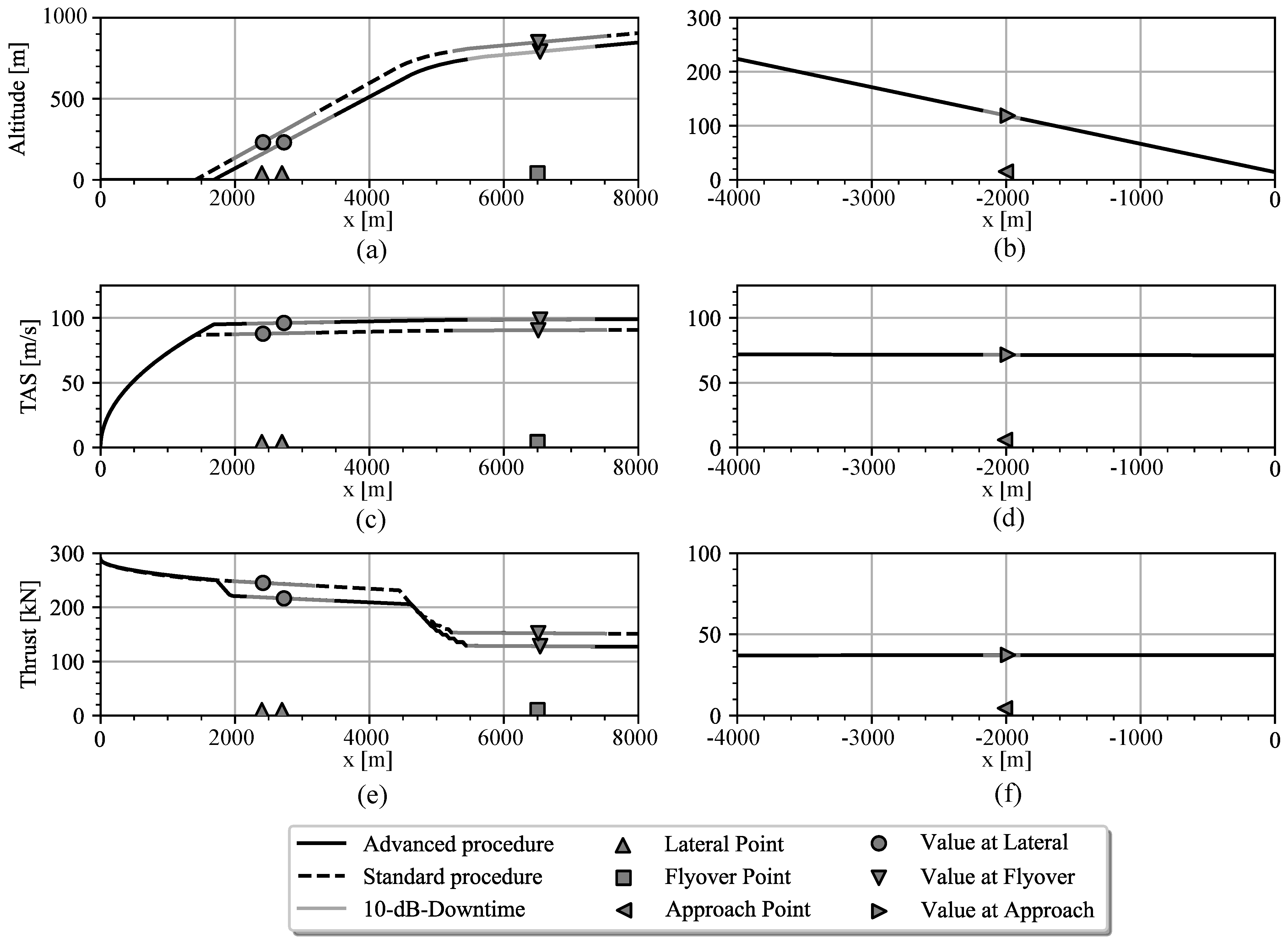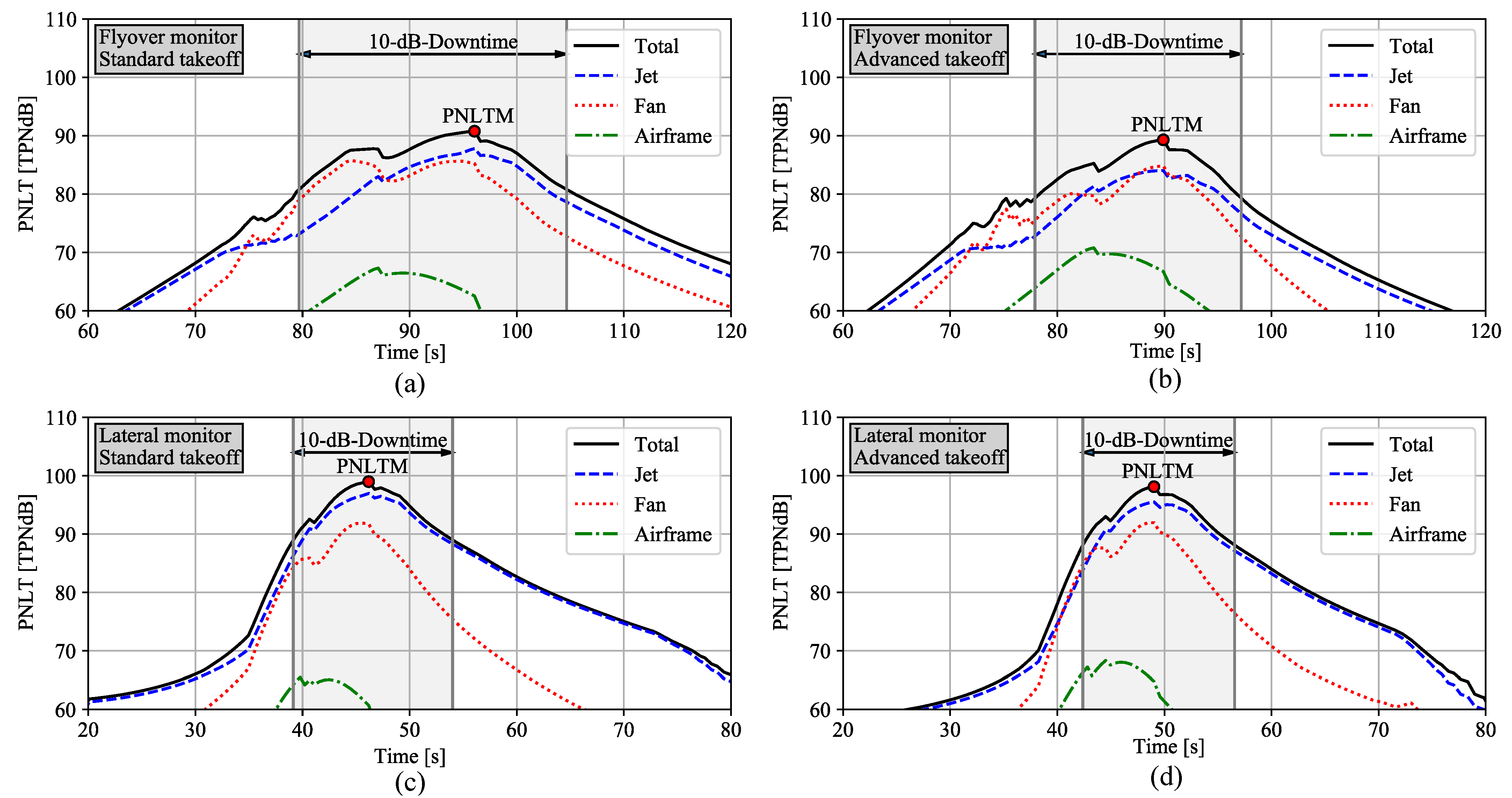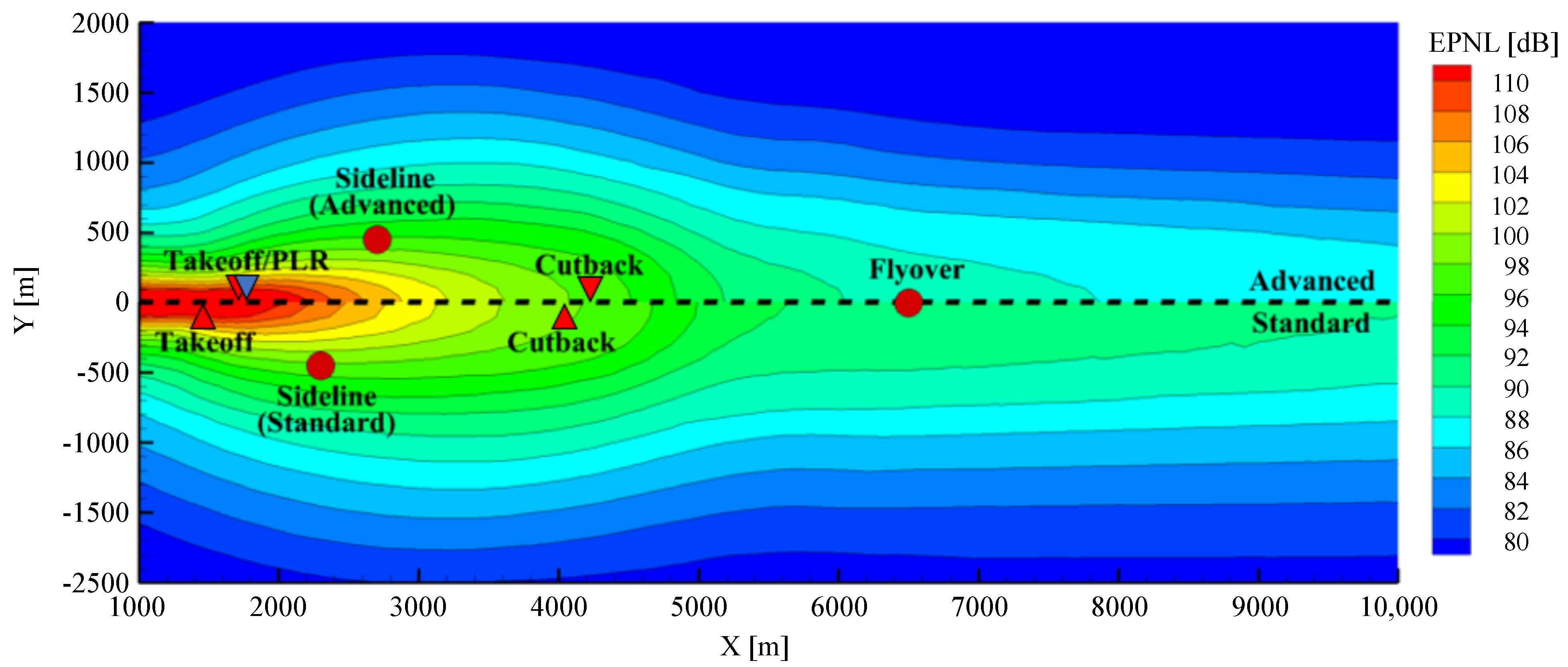Current concepts from manufacturers usually feature under-the-wing engine installations, where advantageous noise shielding through the wing and fuselage cannot be exploited. Therefore, a further configuration is investigated that addresses this aspect in order to estimate the magnitude of noise certification levels of such configurations. Based on an available SST aircraft design [
14], the influence of the flight procedure under the proposed FAA certification rules are assessed, i.e., via dedicated parameter sensitivities. The DLR simulation process can generate arbitrary noise metrics, e.g., SPL(t), SEL, LAMAX, EPNL, and even Sound Quality metrics [
39,
40]. With the focus on certification, the assessment within this study is limited to EPNL. Levels at selected observer locations and the actual noise distribution along the entire flight trajectory are investigated.
The aircraft and engine details are described in the following section. Thereafter, the flight simulation and noise prediction results are presented.
5.1. Aircraft and Engine Design
The basic aircraft that is used for the study presented in this publication has been derived within the frame of conceptual/preliminary design. The selected aircraft is well described in Ref. [
14] and its geometrical data is provided in
Table A1. The results of the aircraft design process are given in
Table A3. The aircraft data presented here originates from this source except of an updated engine design. The aircraft
TWO is equipped with a scaled version of the DLR engine described in
Table 2. The aircraft is designed to carry eight passengers, equal to 726 kg of payload, along a range of 7500 km (4050 nautical miles), thus providing transatlantic capability. Its maximum fuel volume is (
) is 44.7 m
.
However one significant change has been made for this study by reducing cruise speed at the design point of the aircraft from Ma = 1.6 to Ma = 1.4. The change to a lower Mach number in this publication is a result of current trends in the design of supersonic business jets as outlined in the introduction. Consequently the resulting aircraft does have a lower Maximum Take-off Mass (
) than the basic design from Ref. [
14] and it thus requires engines with less static thrust. Keeping in mind that this publication focuses on acoustics, the Ma = 1.4 design promises a more favorable starting point with respect to engine noise compared to an aircraft with a design speed of Ma = 1.6.
An extract to the requirements is given in
Table A2.
5.2. Flight Simulation and Noise Prediction
To determine the trajectories for standard and advanced take-off, an optimization was performed taking into account the ICAO noise certification regulations, which includes a variation of airspeed, thrust and cutback height. The standard definition of NASA was chosen as a reference Reference [
9]. The aim of this optimization was to minimize the certification level at the individual noise measurement points. The results are shown in the form of EPNL at the flyover measurement point above relative engine speed in
Figure 5 for the standard (bottom) and the advanced departure procedure (top). In addition, a figure of all trajectories evaluated for the variation is included in the
Appendix A in
Figure A2. The noise certification regulations limit the ranges of the individual flight path parameters, e.g., minimum climb rate (4%), minimum cutback altitude for two engines (300 m), and maximum cutback altitude, respectivly the requirement that the thrust reduction of the cutback must be completed before the measurement of the EPNL at the flyover point. The application of the highspeed climbout allows the thrust for the advanced procedure to be reduced further after the pilot-initiated cutback, due to the decreased thrust requirement as described above. Obviously, the lowest certification level at the flyover measurement point results for the highest cutback altitude still allowed, whereas this altitude is larger for the standard procedure, since there is no additional thrust reduction through PLR and thus a faster increase in flight altitude. For both procedures, the lowest EPNL occurs in the range of low relative engine speeds. As can be seen, it is also confirmed for the aircraft
TWO that an advanced procedure or a highspeed climbout results in a reduction at the flyover measurement point. In the following, the two procedures with the lowest EPNL are analyzed in more detail.
Figure 6 provide the resulting trajectories as simulated for this vehicle, i.e., take-off (left) and approach (right), respectively. The proposed SST rule changes refer to the take-off situation only, so that it is sufficient to assess one approach procedure here.
Since the engines are mounted under the wing in the configuration investigated, no effective shielding of the engine noise can be achieved here, as was observed with the NASA 55t STCA. For this reason, the modeling of the shielding effect was neglected in these investigations. The lateral measurement position was calculated separately for each simulated trajectory and the position with the highest EPNL was selected for noise assessment.
Although the maximum take off mass is very similar, the aircraft TWO has a higher thrust excess compared to NASA 55t STCA due to the smaller number of engines. The reason for this is that, airworthiness regulation requires an aircraft to be able to take-off with one engine inoperative. This means that the aircraft TWO requires a shorter runway length and can gain altitude more quickly. The characteristic take-off speed V2, which determines the speed limitation in the departure procedure of the noise certification, is lower for the aircraft TWO than for the NASA 55t STCA. Nevertheless, the speed differences between standard and advanced procedure are the same.
In order to achieve a higher flightspeed (V2 + 35 kn) for the highspeed climbout, a delayed rotation take-off is used in the advanced take-off, which results in a significantly longer runway length of approx. 1690 m compared to the standard take-off (approx. 1410 m) with lower flightspeed (V2 + 20 kn). As a result, the aircraft has a higher altitude along the standard take-off, which can be advantageous on the ground due to atmospheric attenuation and distance. However, due to the variable position of the lateral measurement point, there is a shift of the highest EPNL and thus the selected lateral measurement point position relative to the brake release point changes from 2300 m to 2700 m. It is observed that flight altitude above the lateral measurement point as well as the relevant range of the trajectory related to altitude is very similar for the two procedures.
For the approach simulation a 3° glide path with a height of 120 m above the measurement point is assessed, i.e., with the aircraft in a stable flight condition. For the aircraft TWO, this results in an airspeed of 71.48 m/s above the measurement point with a constant total thrust of 37,160 N over the relevant area of the flight path according to the specifications with Vref+10 knts.
5.3. Noise Assessment
In order to assess the advanced and standard departure and the approach procedure, the tone corrected perceived noise data (PNLT) for the total aircraft as well as for individual noise components (jet, fan, airframe), are depicted in
Figure 7 and
Figure 8. In addition, the area of the 10 dB-down time relevant for the calculation of the EPNL and the maximum of the tone corrected perceived noise level (PNLTM) are highlighted in the figures. Predicted EPNL are summarized in
Table 4.
In both PNLT plots (standard and advanced), there are two distinct local peaks, which can be attributed to forward and backward radiated engine noise contribution. The first peak is associated with the fan contribution, cf. see red dotted lines. The second peak is at a significantly higher level and can be associated with the rearward radiated jet contribution.
The following differences in noise source ranking along standard and advanced procedure can be identified for the aircraft
TWO. Jet noise is dominating the fan noise at the lateral measurement point by +5 dB along the standard and by +3.5 dB along the advanced flight procedure, respectively. At the flyover measurement point the contribution of both noise sources, i.e., jet and fan, is of similar magnitude due to the reduced thrust setting (thrust cutback) and the resulting reduction in jet exhaust velocity. In general, the influence of the fan on total aircraft noise is higher along the advanced take-off compared to the standard procedure due to the PLR and the highspeed climbout. Fan noise influence is increased due to a lower jet noise contribution which is a direct consequence of the PLR thrust reduction and the increased flight speed along the highspeed climbout as already mentioned in Ref. [
10]. Consequently, the effectiveness of fan noise shielding is increased along the advanced procedure as can be demonstrated for NASA 55t STCA. The highspeed climbout has a larger effect on the flyover measurement point, which also confirms the observations of NASA.
Only one approach flight is simulated for the aircraft
TWO as described above. The predicted PNLT is plotted in
Figure 8. Jet noise contribution is significantly decreased, revealing a dominant fan noise. Airframe noise levels are still insignificant even for this approach situation. The predicted EPNL are listed in
Table 4 and no additional approach contour plots are shown in this paper. These plots are omitted since only one approach flight procedure is considered in the study.
Certification Noise Levels
The predicted EPNL values are now compared to available noise limits specified according to the Noise Chapters of ICAO Annex 16 [
37] and the proposed FAA regulations [
4], see
Table 4. At the departure measurement points, defined limits of the FAA NPRM are exceeded by the aircraft
TWO along the standard departure (+1.8 EPNdB at the flyover point and +1.7 EPNdB at the lateral point). Applying the advanced procedure for this vehicle will reduce the noise levels but still exceed or barely met the limits (−1.1 EPNdB at the flyover point and +0.7 EPNdB at the lateral point). As already mentioned, exceeding the limits at the individual measurement points is no longer permitted, which is why certification according to the proposals of the NPRM or any other than ICAO Noise Chapter 3 would not be possible for the aircraft
TWO.
Overall, noise level reductions along an advanced procedure can be confirmed for the aircraft TWO vehicle but are of reduced effectiveness compared to an over-wing aircraft as documented by NASA and the comparative study with the novel simulation process already shown for the 55t STCA. Compared to the 55t STCA, the limits are exceeded not only at the lateral point but also at the flyover measurement point, which results from similar EPNL and the reduced number of engines. An aircraft, like the aircraft TWO, with two engines requires more thrust for a similar take-off mass, which leads to higher nozzle exit velocities and thus more jet noise.
For a better comparability of the two procedures, the predicted EPNL contours for both departure procedures are depicted, see
Figure 9. The upper half of the plot shows the EPNL for the advanced take-off procedure and the lower half the EPNL for the standard take-off procedure. The longer acceleration on the ground extends the area with increased EPNL along the advanced procedure, as the aircraft stays longer on the ground. This is confirmed by a different lateral measurement position along the two procedures. After the pilot initiated cutback, the contour areas strongly decrease and become narrower for the advanced procedure compared to the results of the standard procedure. In summary, the advanced procedure reduces the EPNL countour areas of the aircraft
TWO with the exception of the area shortly after take-off. Nevertheless, for the two certification measurement points lateral and flyover, smaller EPNLs result for the advanced procedure are observed.
